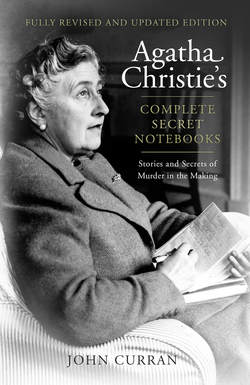Читать книгу Agatha Christie’s Complete Secret Notebooks - Агата Кристи, Agatha Christie, Detection Club The - Страница 61
The murderer
ОглавлениеThe other important figure, the murderer, also exercised both rule-makers. But Christie had broken most of these Rules before either Knox or Van Dine even compiled them.
Knox 1. The criminal must be someone mentioned in the early part of the story, but must not be anyone whose thoughts the reader has been allowed to follow.
While adhering to the former part of this injunction, the circumvention of the latter became almost a motif throughout Agatha Christie’s writing life. As early as 1924 with The Man in the Brown Suit she neatly and unobtrusively breaks this rule, via Sir Eustace Pedler’s diary. The most famous, or infamous, example is, of course, The Murder of Roger Ackroyd, her first for the publisher Collins. The book immediately ensured her fame and success and it is safe to assert that, even if she had never written another word, her name would still be remembered today in recognition of this stunning conjuring trick. Forty years later she replayed it but in such a different guise that most of her readers were not aware of the repetition. While a doctor in a small 1920s village narrates The Murder of Roger Ackroyd, a young, working-class, charming ne’er-do-well narrates Endless Night. But it is essentially the same sleight of hand at work. (See also ‘Fairness’ above.)
More subtly, we share the thoughts of a group of characters, which includes the killer, in And Then There Were None, but without identifying which thoughts belong to which character (Chapter 11). And in The ABC Murders we think we are sharing the thoughts of a serial killer when, in fact, he is the innocent dupe of the real killer. Less overtly, we are given an insight into the minds of the killer in Five Little Pigs, Towards Zero and Sparkling Cyanide.
Van Dine 10. The culprit must turn out to be a person who has played a more or less prominent part in the story.
Never one to cheat her readers, this is one of the Rules that Christie did not break. She never unmasked the second cousin of the under-housemaid as the killer in the last chapter. Taking her cue from ‘The Purloined Letter’, the Queen of Crime hid her murderers in plain sight.
Van Dine 11. A servant must not be chosen as the culprit.
This is not mere social prejudice (although there is plenty of that in the work of Van Dine himself) but a practical solution to the problem of the unmasking, in the last chapter, of a member of the domestic staff whose presence in the novel was fleeting at best. Consider how Christie overcame this stricture. Kirsten Lindstrom in Ordeal by Innocence is, strictly speaking, a domestic servant but her significance to the Argyle family can be interpreted as placing her outside this category. But it is as a servant that we meet, and continue to perceive, her. This same consideration applies to Miss Gilchrist in After the Funeral; witness the telling scene at the denouement when she bitterly recriminates the Abernethie family. Gladys, in A Pocket Full of Rye, is a clearer example of domestic servitude; indeed, it is her status as such that makes her a vital element of Lance’s murderous plan. In defence of Christie’s oft-criticised attitude to domestic servants, it is the subsequent death of Gladys that causes Miss Marple to arrive at Yewtree Lodge to avenge the death of a foolish and gullible former maid. And the closing pages of the book, as Miss Marple reads a letter from Gladys written just before her murder, are very affecting. The same plot device, and much of the same plot, can be seen in the earlier short story ‘The Tuesday Night Club’ in The Thirteen Problems.
Van Dine 17. A professional criminal must never be shouldered with the guilt in a detective novel.
Apart from brief – and not totally convincing – forays into organised crime in The Big Four, The Secret of Chimneys and At Bertram’s Hotel, no use is made of a professional criminal in Christie’s solutions.
Van Dine 12. There must be but one culprit no matter how many murders are committed.
Murderous alliances are a feature of Christie’s fiction beginning with The Mysterious Affair at Styles and continuing with The Murder at the Vicarage, Death on the Nile, One, Two, Buckle my Shoe, Evil under the Sun, The Body in the Library, Sparkling Cyanide and Endless Night. Cat among the Pigeons and, to a lesser degree, Taken at the Flood, feature more than one killer working independently of each other; The Hollow features an unusual and morally questionable, collusion; and, of course, Murder on the Orient Express features the ultimate conspiracy.
